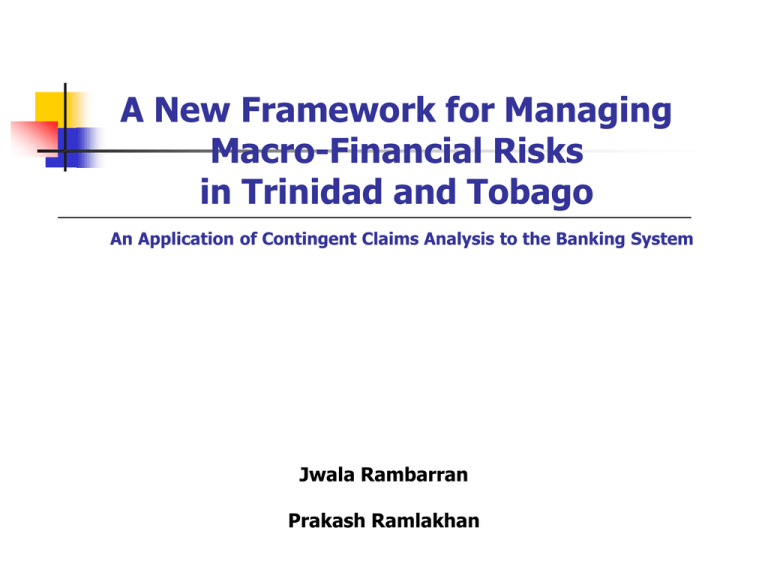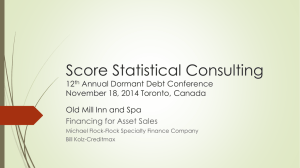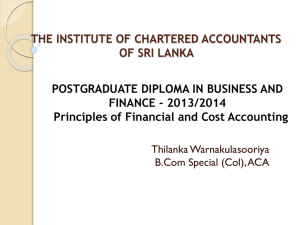A New Framework for Managing Macro
advertisement

A New Framework for Managing Macro-Financial Risks in Trinidad and Tobago An Application of Contingent Claims Analysis to the Banking System Jwala Rambarran Prakash Ramlakhan Introduction Global financial crisis demonstrates the vulnerability of economies to volatilities in the markets: Credit Commodities Currencies What Have We Been Missing? “Study of financial fragility has not been well served by macroeconomic theory. Financial fragility is intimately related to probability of default. Default is hard to handle analytically being a discontinuous, nonlinear event so most macro models abstract from default and financial intermediaries such as banks.” Charles Goodhart 2005 Joint INS/MCM Conference Need for New Frameworks Regulators need to find complementary approaches beyond traditional macro models to assess banking risk and sector exposure. Contingent Claims Analysis is a relatively new technique that incorporates economics, finance and risk management to assess macro-financial risk. Contingent Claims Analysis Single Entity Risk Firms, Banks, Sovereign Macrofinancial Risk Interlinked, balance sheets Contingent Claims Analysis According to the IMF working paper (WP/04/121) “applying the CCA retroactively to the aggregate industry sector in Brazil would have provided an accurate view of pending financial difficulties within the Brazilian corporate sector” The IMF went on to state that the data suggest similar success of the CCA model in Thailand (late 1990s) CCA Principles The contingent claims approach defines the relationship between value of asset and value of claim. The model is based on three principles: (i) the values of liabilities are derived from assets (ii) liabilities have different priority (i.e. senior, subordinated and junior claims) (iii) assets follow a stochastic process. Thinking About Default Risk Three main elements determine default probability: Market value of assets Uncertainty and risk in future asset value Leverage: the extent of contractual liabilities Note: emphasis on a marked-to-market balance sheet, where market value of assets is weighed against obligated payments Key Relationships Concerning Default Risk Asset Value Distribution of Asset value Debt V0 T Time Thinking About Default Risk The risks to investors lie in the inability of the firm to meet expected payouts. Distress /default : value of assets < debt the point when distress sets in is known as the distress barrier (DB) DB is usually close to the value of debt Thinking About Default Risk Problem: asset value and asset risk unobservable Solution: used an implied measure We can’t observe A and σ directly, but they influence the value of something we can observe—the value of the firm’s equity Our understanding of options and capital structure will help us make the connection Contingent Claims Analysis Debt holders have senior claim on firm assets Equity has a junior claim on firm assets Paid first, limited upside, control assets if default Payoff: Min (DB, VA(T)) Junior claim, paid after bonds, but unlimited upside Payoff: Max (0, VA(T) - DB) Return on equity looks like a call option The underlying = firm’s assets Strike price = value of liabilities (DB) Payoff to Debt and Equity Asset Payoff Junior equity VA-DB Senior debt 0 DB VA=Asset Value Option Assets and debt are related using implicit options. Therefore, used option pricing model to price these relationships. Black-Scholes Option Pricing Model Equity as a call option on firm assets VE VA N d1 DBerT N d2 2 VA A ln r T 2 DB d1 , d 2 d1 A T A T Also use the following relationship EVE AVA N d1 Solve for VA and σA Market-Based Risk Indicators Distance to Distress Number of standard deviations asset value is from distress barrier (one year) D2D ln A / DB (r A A2 2 ) Probability of Default Cumulative normal distribution N(-d2) Application of CCA to TT Banks Research covers the four largest commercial banks in TT. Advantages of Contingent Claims Analysis Uses a limited number of inputs Market value and volatility of traded equity Distress barrier (DB) from existing debt DB = ST debt + ßLT debt + interest Discount rate Time horizon (usually 1 year) Distance to Distress for TT Banks D2D 2007 2008 2009 2010 B1 2.2 2.5 2.2 2.1 B2 4 4.0 4.0 3.8 B3 1.2 1.5 1.3 1.2 B4 2.2 2.5 2.2 2.67 One Year Default Probabilities – TT Banks 14.00% 12.00% 10.00% 8.00% B1 B2 B3 6.00% B4 4.00% 2.00% 0.00% 2006 2007 2008 2009 2010 One Year Default Probability– TT Commercial Banking sector 1.80% 1.60% 1.40% 1.20% 1.00% Series1 0.80% 0.60% 0.40% 0.20% 0.00% 2006 2007 2008 2009 2010 Application of CCA to TT Banks Findings - TT banks show a very low probability of default with the exception of one. As at year end 2010, Commercial banking sector shows less than 2% probability of default over the next year Default and Provisioning The low default probabilities can be traced to the quality of the assets in the banks – specifically the loan portfolio. Loan loss (2009)under 6% of total assets Ratio of Loan loss /total loans is lower than asset volatility. Loan loss/Total assets Loan Loss/Total Asset 12.00 Percentage 10.00 B1 8.00 B2 6.00 B3 4.00 B4 2.00 2006 2007 2008 Year 2009 Conclusion CCA as a tool in managing macro-financial risk shows that the TT commercial banking sector is strong. The research supports financial soundness indicators. The increase in systemic risk can be traced to domestic and global markets uncertainties Conclusion Other areas for research – extend CCA to insurance companies and credit unions; incorporate into monetary policy models. Possibly the need for (additional) market based data in statutory reporting THANK YOU











